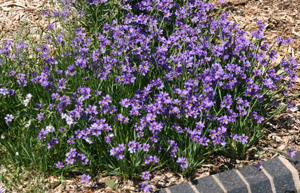
Despite it’s common name, blue-eyed grass is not a grass. The genus Sisyrinchium is a large group of annuals and perennials in the iris family (Iridaceae). But many species are low growing with narrow leaves that appear grass-like and many grow in grasslands. All are native to North or South America. Most are not well known and only a few are used as ornamentals. The taxonomy of the group is quite confused, so the number of species varies from 50 to 150, depending on which classification system is used. Some species have many natural variants that were likely mis-named as species – so more research is needed to figure out the true relationships.
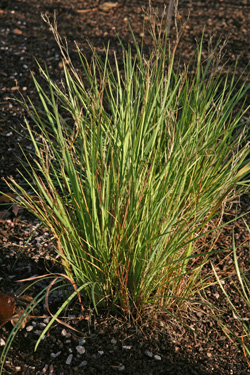
Sisyrinchium plants all have clumps of stiff, upright, sword-shaped leaves held in a fan shape – just like most of their relatives in the iris family. However, the individual leaves are usually narrower than that of a typical iris plant, giving a grass-like appearance. They grow from thin rhizomes that gradually spread outward from the clump. Some species are evergreen, while many others — especially in colder areas — die back to the ground in winter. In spring or summer small flowers appear on spikes at or just above the foliage. Individual flowers emerge from a green spathe slightly wider than the supporting branch.
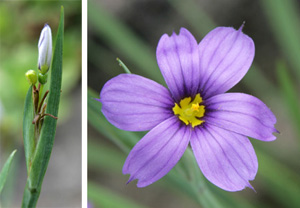
The star-shaped flowers with 6 pointed tepals (three petals and three almost identical sepals, although the sepals are typically slightly wider than the petals) typically have a yellow center. The flowers close in the afternoon or evening and open up again in the morning. Although most North American species do have blue flowers as the common name suggests, some species, especially the South American ones, have white, yellow, or purple flowers. S. californicum has the common name California Golden-eyed Grass for its yellow flowers. If pollinated, flowers are followed by small, round, dark brown or black seed capsules filled with tiny black seeds. Birds may eat the seeds.

One of the most common species offered as an ornamental perennial is S. angustifolium, narrowleaf blue-eyed grass. (The common name suggests unusually narrow leaves, but the leaves, which are only up to 3/16″ wide, are actually wider than many other species.) This species includes plants formerly classified as S. bermudianum, S. gramineum and S. graminoides. This native of eastern North America, from Florida through Canada, occurs primarily in damp open woods and along stream banks, but is sometimes found in more open grassy areas and meadows. The deep violet-blue, ½ inch wide flowers with yellow eyes are borne on distinctively flattened or winged, branched stems, held just above the clump of 8-20″ tall foliage. Plants bloom from late spring into early summer. This species is hardy in zones 4-9. The variety ‘Lucerne’, discovered growing in a nursery near Lucerne, Switzerland, produces more and larger flowers than the species over a longer bloom period (well into summer and sometimes until fall) on plants 8-12″ tall. It does not self seed as readily as the species.
Some other species and hybrids found in cultivation that are hardy in the Midwest include:
- S. albidium, white blue-eyed grass, comes from fields, glades and open woods of eastern North America. The white to pale blue flowers with yellow eyes bloom in early to mid-spring on unbranched flower stems, usually with two clusters of flowers on each stem. Plants grow up to 20″ tall and are hardy in zones 3-9.
- S. campestre, prairie blue-eyed grass, is common in the Midwestern prairies. It is native to the central part of North America, from Texas to Manitoba, primarily west of the Mississippi, but also including Wisconsin and Michigan. It is found naturally in open woods, glades, prairies and grassy areas and is hardy in zones 2-9. The white to pale blue flowers appear on unbranched flower stems in mid-spring to mid-summer. A white-flowered form, S. c. albiflorum, is sometimes offered.
-
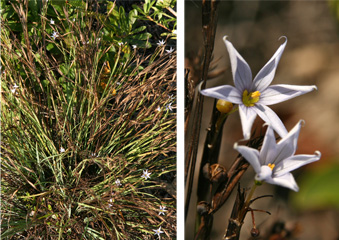
Sisyrinchium mucronatum
S. idahoense is a western species native from Washington to New Mexico with narrow, dark green foliage blooms in summer, with violet-blue flowers. Hardy in zones 4-9, it is found naturally in moist, sandy soils. - S. montanum, strict blue-eyed grass, is a more northern species that is very similar to S. angustifolium, differing primarily in having unbranched flower stems and slightly wider leaves. It is found throughout much of North America, except the far west and southeast. It can reach 24″ in height and produces 1″ wide blue-violet flowers on unbranched stems.
- S. mucronatum, needletip blue-eyed grass, grows to 16″ tall in height. The narrow leaves are shorter than the very narrow, unbranched stems and the solitary spathesare red-purple. It grows naturally in the eastern part of North America well up into Canada.
-
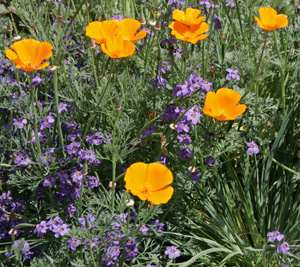
Sisyrinchium bellum with California poppy
S. x bellum ‘E. K. Balls’ (or ‘Ball’s Mauve) is a hybrid with 3/4’” mauve flowers. Plants are typically 6-8″ tall and are hardy in zones 4-8. - ‘Quaint and Queer’ is a hybrid with brown or dull purple flowers with yellow eyes on flattened flower stems rising 9-10″ tall, above the 6″ foliage in late spring. Zones 5-8.
Grow blue-eyed grass in full sun in well-drained soil. Although they will grow in partial shade, flowering will be reduced. Most species tolerate poor soils and will produce lanky growth in rich soils. As a prairie wildflower, it would experience seasonal flooding in its natural environment, and although it does best in drier soils, it will bloom best with good
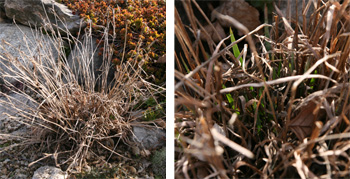
spring and early summer moisture (as long as the soil drains extremely well). Shear after blooming if desired, to improve the appearance of the clump and to prevent self-seeding. Divide every 2-3 years to keep vigorous. Blue-eyed grass has no significant insect or disease problems and is not favored by deer.
Blue-eyed grasses are best used in informal areas, such as cottage gardens, rock gardens and woodland gardens. They naturalize readily, so are well suited to meadows, prairies and native plant areas. Because of their small stature, they work well at the front of borders, in rock gardens or even as an edging along paths. They look nice combined with other native plants such as butterfly weed (Asclepias tuberosa), prairie smoke (Geum triflorum) and blazing star (Liatris spp.).
The species are readily propagated from seed. They can be direct seeded in the fall (to naturally stratify the seed) for spring germination or seeds can be moist stratified for 6 weeks in a refrigerator and then held under cool conditions (50-60ºF) to germinate in 1-2 weeks; typically they will not germinate well at room temperature. Small plants can be set out in late spring or summer. Selections and hybrids should be propagated by division in early spring or fall.
– Susan Mahr, University of Wisconsin – Madison





 Alternatives to Lawn: Groundcovers
Alternatives to Lawn: Groundcovers Marigolds
Marigolds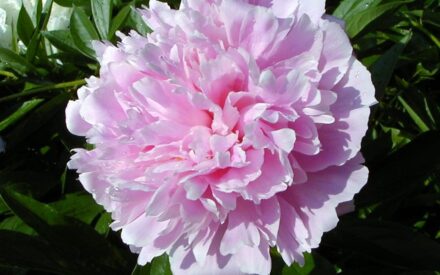 Peony
Peony Iris Severe Mosaic
Iris Severe Mosaic


